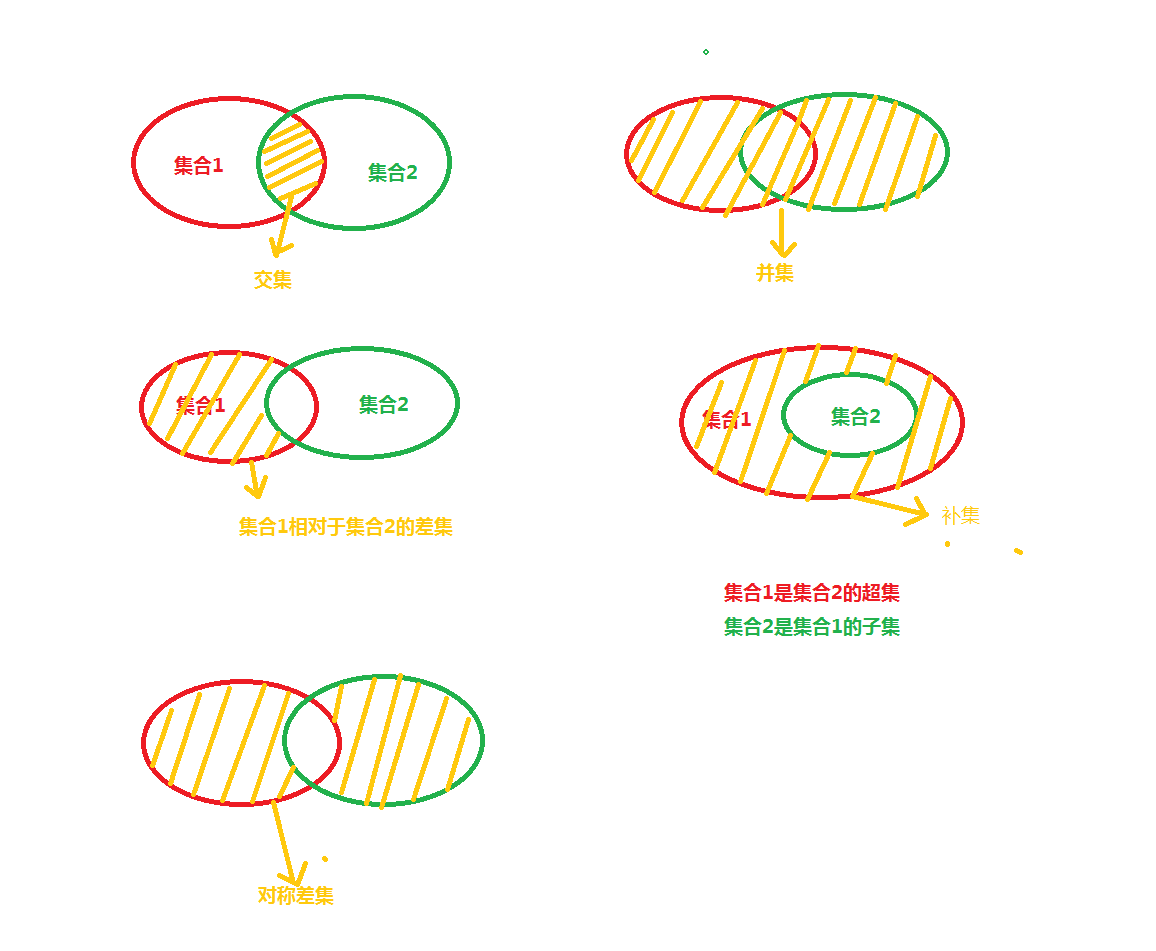C# 集合交、并、差、去重,对象集合交并差
关键词:C# List 集合 交集、并集、差集、去重, 对象集合、 对象、引用类型、交并差、List<T>
有时候看官网文档是最高效的学习方式!
一、简单集合
Intersect 交集,Except 差集,Union 并集
int[] oldArray = { 1, 2, 3, 4, 5 };
int[] newArray = { 2, 4, 5, 7, 8, 9 };
var jiaoJi = oldArray.Intersect(newArray).ToList();//2,4,5
var oldChaJi = oldArray.Except(newArray).ToList();//1,3
var newChaJi = newArray.Except(oldArray).ToList();//7,8,9
var bingJi = oldArray.Union(newArray).ToList();//1,2,3,4,5,7,8,9
二、对象集合
Product[] store1 = { new Product { Name = "apple", Code = 9 }, new Product { Name = "orange", Code = 4 } }; Product[] store2 = { new Product { Name = "apple", Code = 9 }, new Product { Name = "lemon", Code = 12 } }; IEnumerable<Product> union =store1.Union(store2,new ProductComparer()); IEnumerable<Product> except=store1.Except(store2,new ProductComparer()); IEnumerable<Product> intersect=store1.Intersect(store2,new ProductComparer()); IEnumerable<Product> distinct=store1.Distinct(store2,new ProductComparer());
小提示:
1:IEnumerable<Product> 可以简化为 匿名类型 var
对自己去重:
var distinct=store1.Distinct(new ProductComparer());
相对于别人去重
var distinct=store1.Distinct(store2,new ProductComparer());
2: 可以继续进行一些linq或拉姆达操作
var distinct=store1.Distinct(store2,new ProductComparer()).OrderBy(c=>c.Code);
原因是引用了linq组件:using System.Linq;
三、比较类的实现
1 2 3 4 5 | public class Product{<br> public string Id {get;set} public string Name { get; set; } public int Code { get; set; }} |
1只有一个比较条件
//如果对象存在唯一主键,例如:从数据库里查询出来的数据存在 ID class ProductComparer : IEqualityComparer<Product> { // Products are equal if their names and product numbers are equal. public bool Equals(Product x, Product y) { //Check whether the compared objects reference the same data. if (Object.ReferenceEquals(x, y)) return true; //Check whether any of the compared objects is null. if (Object.ReferenceEquals(x, null) || Object.ReferenceEquals(y, null)) return false; //Check whether the products' properties are equal. return x.ID == y.ID; } // If Equals() returns true for a pair of objects // then GetHashCode() must return the same value for these objects. public int GetHashCode(Product product) { //Check whether the object is null if (Object.ReferenceEquals(product, null)) return 0; //Get hash code for the Code field. int hashID = product.ID.GetHashCode(); //Calculate the hash code for the product. return hashID; } }
2 多个比较条件
// 如果存在组合主键或组合唯一索引,即多个字段组合才能确定唯一性。 // Custom comparer for the Product class class ProductComparer : IEqualityComparer<Product> { // Products are equal if their names and product numbers are equal. public bool Equals(Product x, Product y) { //Check whether the compared objects reference the same data. if (Object.ReferenceEquals(x, y)) return true; //Check whether any of the compared objects is null. if (Object.ReferenceEquals(x, null) || Object.ReferenceEquals(y, null)) return false; //Check whether the products' properties are equal. return x.Code == y.Code && x.Name == y.Name; } // If Equals() returns true for a pair of objects // then GetHashCode() must return the same value for these objects. public int GetHashCode(Product product) { //Check whether the object is null if (Object.ReferenceEquals(product, null)) return 0; //Get hash code for the Name field if it is not null. int hashProductName = product.Name == null ? 0 : product.Name.GetHashCode(); //Get hash code for the Code field. int hashProductCode = product.Code.GetHashCode(); //Calculate the hash code for the product. return hashProductName ^ hashProductCode; } }
3 难道我们每次都要“简单重复的”继承IEqualityComparer接口,来重新实现一个“几乎完全相同的”的Compare类吗?
对于只有一个比较条件的简单情况,我们可以直接对 Distinct、Union、Except、Intersect 进行封装,简单通用方法:
来源:C#list去重, https://www.cnblogs.com/hao-1234-1234/p/8855218.html
public class Compare<T, C> : IEqualityComparer<T>
{
private Func<T, C> _getField;
public Compare(Func<T, C> getfield)
{
this._getField = getfield;
}
public bool Equals(T x, T y)
{
return EqualityComparer<C>.Default.Equals(_getField(x), _getField(y));
}
public int GetHashCode(T obj)
{
return EqualityComparer<C>.Default.GetHashCode(this._getField(obj));
}
}
public static class CommonHelper
{
/// <summary>
/// 自定义Distinct扩展方法
/// </summary>
/// <typeparam name="T">要去重的对象类</typeparam>
/// <typeparam name="C">自定义去重的字段类型</typeparam>
/// <param name="source">要去重的对象</param>
/// <param name="getfield">获取自定义去重字段的委托</param>
/// <returns></returns>
public static IEnumerable<T> MyDistinct<T, C>(this IEnumerable<T> source, Func<T, C> getfield)
{
return source.Distinct(new Compare<T, C>(getfield));
}
}
然后这么使用:store1.MyDistinct(s=>s.Id).ToList();
Id 是用于较的属性(或字段),它是可以是任何一个属性。
4、多个比较条件 的通用方法如何实现?
类似于 store1.MyDistinct(s=>s.Id&&Name).ToList();
四、微软官方文档
union :https://docs.microsoft.com/zh-cn/dotnet/api/system.linq.enumerable.union?view=netframework-4.8
intersect:https://docs.microsoft.com/zh-cn/dotnet/api/system.linq.enumerable.intersect?view=netframework-4.8
except:https://docs.microsoft.com/zh-cn/dotnet/api/system.linq.enumerable.except?view=netframework-4.8
distinct:https://docs.microsoft.com/zh-cn/dotnet/api/system.linq.enumerable.distinct?view=netframework-4.8
合交并差 核心代码是相同的: IEqualityComparer 。
建议在看看文档其它部分,以备后用,文档写的很棒!
例如:join 某些情况与union等效。
五、交集、并集、差集、补集、对称差集 示意图,

后两者后可以有前三者演变而来。补集可以求差或去重、对称差集可以先求差、在求并;
参考过的文章
https://www.oschina.net/code/snippet_222150_16997
http://www.cnblogs.com/flywing/p/5912242.html
https://blog.csdn.net/wizblack/article/details/78796557






【推荐】国内首个AI IDE,深度理解中文开发场景,立即下载体验Trae
【推荐】编程新体验,更懂你的AI,立即体验豆包MarsCode编程助手
【推荐】抖音旗下AI助手豆包,你的智能百科全书,全免费不限次数
【推荐】轻量又高性能的 SSH 工具 IShell:AI 加持,快人一步
· 开发者必知的日志记录最佳实践
· SQL Server 2025 AI相关能力初探
· Linux系列:如何用 C#调用 C方法造成内存泄露
· AI与.NET技术实操系列(二):开始使用ML.NET
· 记一次.NET内存居高不下排查解决与启示
· 阿里最新开源QwQ-32B,效果媲美deepseek-r1满血版,部署成本又又又降低了!
· 开源Multi-agent AI智能体框架aevatar.ai,欢迎大家贡献代码
· Manus重磅发布:全球首款通用AI代理技术深度解析与实战指南
· 被坑几百块钱后,我竟然真的恢复了删除的微信聊天记录!
· AI技术革命,工作效率10个最佳AI工具
2017-02-20 《小猪》
2017-02-20 转载-asp.net id 和name的区别